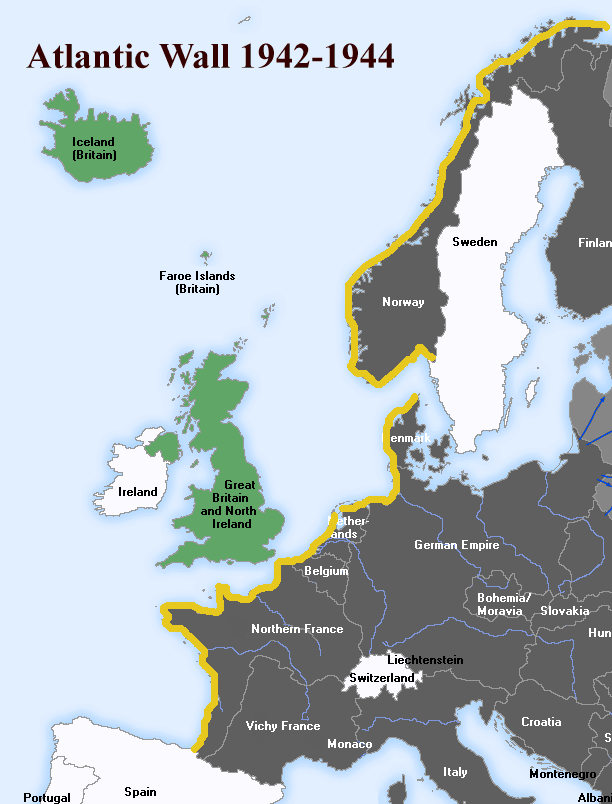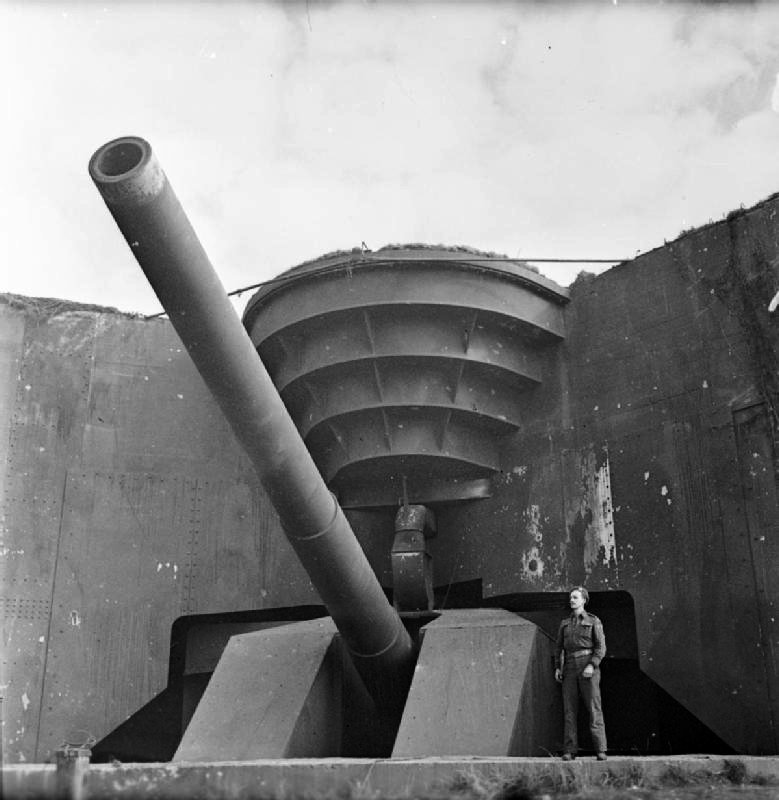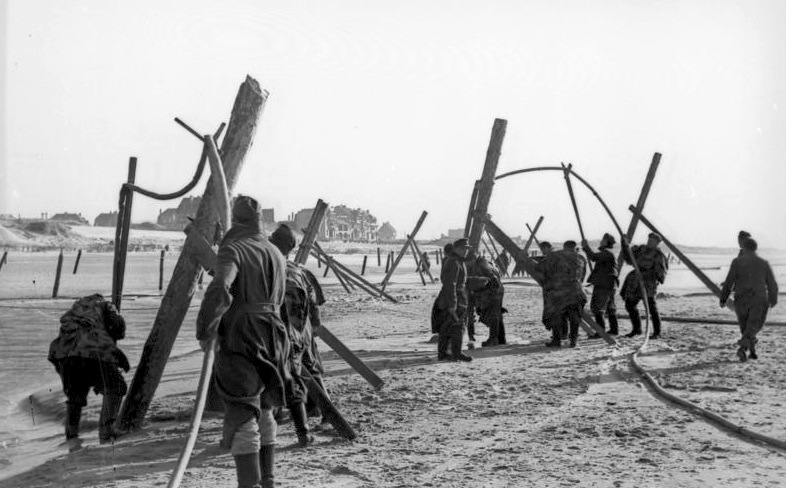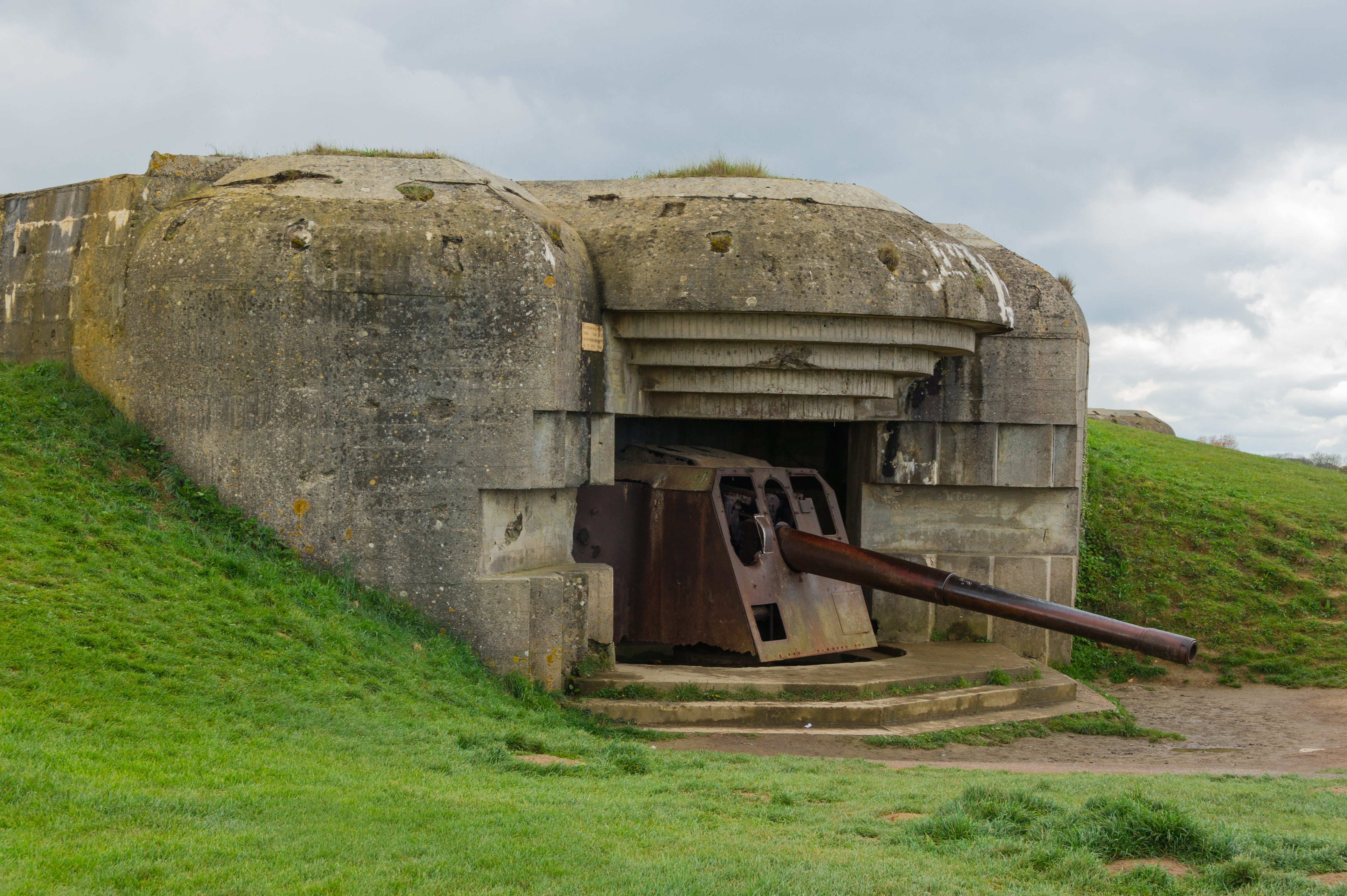Introduction to Atlantic Wall
The Atlantic Wall was a vast network of coastal defences and fortifications constructed by Nazi Germany from 1942 to 1944 along the coasts of continental Europe and Scandinavia in order to provide protection against the Allied invasion that the Germans were anticipating would occur in Nazi-occupied Europe from the United Kingdom, during the World War II.
The manning and operation of the Atlantic Wall were administratively overseen by the German Army with some support from Luftwaffe ground forces. Independent of this, however, was the Kriegsmarine’s (German Navy) separate coastal defence network which was organized into a number of sea defence zones.

In 1942, Hitler ordered its construction under Führer Directive No. 40. He forced over half a million French workers to work for him. Often the size and strength of the wall were overstated in Nazi propaganda.
Among other colossal installations were the gigantic coastal guns, batteries, mortars, and artillery; thousands of pieces of artillery defended the walls. All of the nations have remnants of the wall that is left in each of their states, while some structures fell into the ocean or were destroyed along the years.
Background
World War II in Europe started on 1 September 1939, when Nazi Germany invaded Poland. Two days later, the UK and France declared war on Germany. However, the geographical location of Poland prevented the Allies from intervening directly. Four weeks into the attack, the Germans had successfully occupied Poland.
Less than a month after this victory, Adolf Hitler issued a directive stating that Germany must be ready for an offensive through France and the Low Countries. However, the Oberkommando der Wehrmacht (German high command; OKW) was convinced that preparations would take at least until the following year. After furious arguments, Hitler reluctantly agreed to wait. In May 1940, three huge German army groups overran France and the Low Countries in little more than six weeks.
History
Creation
Before the Atlantic Wall decision, following a number of commando raids, on 2 June 1941 Adolf Hitler asked for maps of the Channel Islands. These were provided the following day and by 13 June 1941 Hitler had made up his mind. Having decided the defences were inadequate, lacking tanks and coastal artillery, ordering more men to the battle Islands, the OT was instructed to undertake the building of 200–250 strong points in each of the larger islands.

The plan was finalized by the OT and submitted to Hitler. The original defense order was strengthened by a second order dated 20 October 1941, again after a Fuhrer conference on 18 October to deal with the situation regarding the engineers’ evaluation of needs. The permanent fortification of the Channel Islands had to transform it into an impregnable fortress to be ready within 14 months. Festungspionierkommandeur XIV had to be formed in order to lead this plan of fortifying the Channel Islands.

It was six months later on 23 March 1942 that Hitler issued Führer Directive No. 40, calling for the construction of an “Atlantic Wall.” He ordered naval and submarine bases to be heavily defended. Fortifications remained concentrated around ports until late in 1943, when defences were increased in other areas. This decision required the army engineers and the OT to organise quickly. For vast quantities of cement, steel-reinforcing as well as armor plating, with all of them needing to be moved.
There were claims at Nazi propaganda times that the fence was from cape of Norway downwards to the borders of Spain.
Regelbau
The Regelbau (standard build) system utilized books of plans for each of more than 600 approved types of bunker and casemate, each of which had a specific purpose, and these were updated as enemy constructions were overrun and examined, some even being tested to destruction for effectiveness. They used standardized armor parts with around 200 plus, such as an entrance door at right angles, armored air intake, steel doors 30 millimetric (1.2 in) thick, ventilation and telephones, and lined internal walls made of wood with an emergency exit system.

The standardization greatly simplified the manufacture of equipment, the supply of materials, and the budgetary and financial control of the construction as well as the speed of planning for construction projects.
To fill out these shortages, captured equipment from the French and other occupied country’s armies were incorporated in the defenses, casemates designed for non-German artillery, anti-tank and machine guns, and the use of turrets from obsolete tanks in tobrukstand pillboxes (tobruk pits).
Organisation Todt
Organisation Todt (OT), established in 1933, had planned the Siegfried Line during the prewar years along the Franco-German border. OT was the chief engineering group responsible for the design and construction of the wall’s major gun emplacements and fortifications.

The OT provided supervisors and labor and also organized supplies, machinery, and transport to complement the staff and equipment of construction firms. Many of them were German, but construction firms in the occupied countries tendered for contracts. Firms could apply for OT work or be mobilized.
Companies that were unable to get their work done on time-which was always possible because the OT controlled the material and manpower of each firm-could be closed down, or more probably fined, taken over, or merged with another firm to create a more efficient larger unit. Successful firms could make attractive profits.
The OT acquired quotations for necessary works and entered into contracts with each construction company, specifying the amount and terms of the contract such as bonus for efficiency, the wage rates and bonus payments applicable to OT staff, which again depended on the nationality and skills. There might be several construction companies working at one site.
Labour included skilled volunteers, engineers, designers, and supervisors, who were paid and treated well. Next came volunteer workers, often skilled technicians, like carpenters, plumbers, electricians, and metal workers. Again, these workers were paid, took holidays, and were well treated. Then came unskilled forced labour, paid very little and treated quite harshly. Finally came effective slave labour, paid little, badly fed, and treated very harshly. The OT ran training courses to improve labour skills.
Massive numbers of workers were required. The Vichy regime introduced a forced labor system, drafting some 600,000 French workers to build these permanent fortifications along the Dutch, Belgian, and French coasts facing the English Channel. Efficiency of the OT declined in late 1943 and 1944 due to manpower pressures, fuel shortages, and the bombing of worksites, such as V-weapons sites, where some volunteer workers refused to work in such dangerous areas.
OT Cherbourg in January 1944 handled 34 companies with 15,000 workers and 79 subcontractors. Daily, weekly, and monthly reports indicating progress, work variations, material used, stocks of material, labor hours used per skill type, the weather, equipment inventory and quality, level of supervision, employee absences, staffing levels, deaths, and problems encountered had to be submitted to the OT.
British attacks
Throughout most of 1942–43, the Atlantic Wall remained a slack front for the Axis troops manning it, with only two large-scale British attacks. Operation Chariot, launched near St Nazaire in March 1942, successfully destroyed German pumping machinery for, and severely damaged, the Normandy dry dock and installations. The second was the Dieppe Raid launched in August 1942, close to the French port of Dieppe, in an attempt to test the German defenses and to provide Canadian troops with battle experience.
At St. Nazaire, the Germans were defeated, but at Dieppe they were able to easily repel the attack and cause heavy casualties. Although the Dieppe raid had been a catastrophe for the Allies, it stirred up Hitler. He was certain that the Allies would immediately launch an invasion in the West. After the Dieppe landing, Hitler brought Field Marshal Gerd von Rundstedt, the overall Commander-in-Chief of the Germans in the West, 15 more divisions into shore up his German positions.
Reorganisation
Early in 1944, with an Allied invasion of Nazi-occupied Europe becoming ever more likely, Field Marshal Erwin Rommel was assigned to improve the wall’s defenses. Believing the existing coastal fortifications to be entirely inadequate, he immediately began strengthening them. Rommel’s main concern was Allied air power.
He had seen it first-hand when fighting the British and Americans in North Africa, and it had left a profound impression on him. He was worried that any German thrust would be intercepted by Allied planes long before it reached the shore in a coherent group.

Hundreds of reinforced concrete pillboxes were built by him under his supervision along with beaches, or sometimes inside, to install machine guns, antitank guns, as well as light and heavy artillery.
Land mines and antitank obstacles were sown on the beaches, and underwater obstacles and naval mines were laid in waters just offshore. Little known was that touch-sensitive mines were placed atop the beach obstacles. The intent was to destroy the Allied landing craft before they could unload on the beaches.
D-Day
By the time of the Allied invasion, the Germans had laid almost six million mines in Northern France. More gun emplacements and minefields extended inland along roads leading away from the beaches. In likely landing spots for gliders and parachutists, the Germans implanted slanted poles with sharpened tops, which the troops called Rommelspargel (“Rommel’s Asparagus”).

Low-lying river and estuarine areas were intentionally flooded. Rommel believed that Germany would eventually be defeated unless the invasion could be halted on the beach. He declared, “It is absolutely necessary that we push the British and Americans back from the beaches. Afterwards it will be too late; the first 24 hours of the invasion will be decisive.”
Channel Islands
The Channel Islands were particularly heavily fortified, especially the closest island to Britain, Alderney. Hitler had decreed that one-twelfth of the Atlantic Wall’s steel and concrete go to the Channel Islands, because the propaganda value was so high with the control over British territory. The islands are some of the most densely fortified areas in Europe, with numerous Hohlgangsanlage tunnels, casemates, and coastal artillery positions.
The Channel Islands were, however, strategically insignificant and were bypassed when the Allies invaded Normandy. The German garrisons based on the islands thus did not surrender until 9 May 1945, one day after Victory in Europe Day. The garrison on Alderney did not surrender until 16 May. Since most of the German garrisons surrendered peacefully, some of the Atlantic Wall sites remain the best-preserved.
The commander in Guernsey printed books giving full pictures, plans, and descriptions of the fortifications on the island, Festung Guernsey.
Preservation
France
Many French construction companies made a profit by contributing to the building of the Atlantic Wall; they were not penalized during the post-war period.
During the immediate post-war period, no one had any interest in saving the wall as the Nazi occupation had created such horrible memories. Many of the beach fortifications have fallen or are underwater, but those inland still stand, primarily because of their location.
One of the best-preserved parts is the Todt Battery. In 2011, renewed efforts to preserve the wall were spearheaded by organisations in Germany, the Netherlands, and the United Kingdom. The question has been raised over whether France should declare the wall a National Monument to ensure it is preserved; however, no government so far has envisaged this.
Elsewhere
Although the defensive wall was never fully completed, many bunkers still exist near Ostend, Channel Islands, on Walcheren, near Scheveningen, The Hague, Katwijk, Noordwijk, Den Helder, and in Scandinavia (Denmark and Norway specifically).





